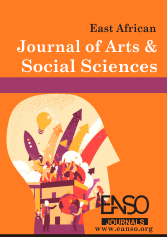Effects of Student Loan Administration Mechanisms on Access to University Education in Uganda
Abstract
This study examines the effect of student loan administration arrangements on access to higher education in Uganda, utilising primarily quantitative and little qualitative evidence derived from a cross-sectional survey of 217 university students selected through stratified random sampling. In applying regression analysis, the study demonstrated a highly significant relationship between funding adequacy and access (R = 0.642, p < 0.01), with perceived funding accounting for 41% of the variation in access. For every one-unit increase in loan perceived adequacy, access increased by 47%, highlighting the key role of sufficient financial provision. The study also determined a moderate but very significant positive correlation between the inclusiveness of the loan scheme—measured in terms of rural coverage, transparency, and publicity—and access among low-income students (R = 0.537, p < 0.01), with 28.4% of the variance accounted for by inclusiveness. Qualitative data suggest that rural and disadvantaged students are discouraged by complex paperwork, the absence of outreach efforts, and language barriers. Additionally, the timeliness of loan approval and disbursement was highly related to student retention (R = 0.491, p < 0.01), with an Odds Ratio of 3.10, such that students with timely disbursements were over three times as likely to remain enrolled. These findings affirm that adequacy of funding, administrative inclusiveness, and timely disbursement are primary determinants of access and persistence. The paper concludes by urging the Ministry of Education, HESFB, and stakeholders to enhance outreach, decentralise service delivery, improve disbursement efficiency, and target support for rural, female, and disadvantaged students to achieve transformative and sustained access to higher education in Uganda
Downloads
References
Cho, S. H., Xu, Y., & Kiss, E. (2019). Understanding student loan decisions: A literature review. Research Gate, 229-248.
Evans, C., Rees, G., Taylor, C. & Wright, C. (2019). Widening access to higher education: The reproduction of university hierarchies through policy enactment. Journal of Education Policy, 34(1), 101- 116, https://doi.org/10.1080/0260939.130165
Kasozi, A. B. K. (2009). Financing Uganda Public Universities: An obstacle to serving the public good. Kampala Fountain Publishers.
Kibuuka, E. (2022). Equitable access, retention and successful completion of undergraduate students in higher education in Uganda. The Uganda Students Higher Education Financing Policy Perspective, Makerere University. Doi: https;//doi.org/10.37284/eajes.5.2.757
Kirabo, M. (2021). Administration of student loan schemes and access to higher education in Uganda. Makerere University Press. https://doi.org/10.5281/zenodo.5799987
Kossey, D., & Ishengoma, J. M. (2017). Political interference and governance challenges in the administration of student loan schemes in Tanzania. Higher Education Studies, 7(3), 25–34. https://doi.org/10.5539/hes.v7n3p25
Kyaligonza, J. (2017). Challenges in the implementation of higher education financing schemes: Lessons from Uganda. Journal of Higher Education Policy and Management, 39(5), 534-548.
Kyaligonza, R. (2017). Gaps in the implementation of Uganda's student loan scheme. Makerere Journal of Higher Education, 9(1), 53-64, Doi:http:dx.org/10.4314/majohe.v911.4
Long, B. T. (2005). Do loans increase college access and choice? Examining the introduction of student loans. England Public Policy Centre. Working Paper, Federal Bank of Boston
Makerere University (2022). Pathways to access to higher education in Uganda 2019-2020. Makerere College of Health Sciences, Kampala, Uganda
Mayanja, M. (1996). University education in Uganda: Quality despite adversity 36(1), 18-29, https://www.researchgate.net.publication
NCHE (2012). The national council for higher education and the growth of the university sector in Uganda, 2002-2012. https://doi.org/10.2307/j.ctuh8r20f
Standish-Kuon, T. (2019). Legislative influences on student loan transparency: A case study of financial literacy disclosure. Journal of Student Financial Aid, 49(2), 1–16. https://doi.org/10.55504/0884-9153.1024
Trow, M. (1973). Problems in the transition from elite to mass higher education. Policy Perspectives in Higher Education, 1(1), 1-14.
Wanyama, M. O., Kyohairwe, S. B., & Karyeija, G. K. (2016). Student loan scheme and access to higher education at Makerere University, Uganda. Journal of Public Administration and Development Alternatives, 1(1), 39-55.
Wanyama, O. M. (2015). The contribution of the student loan scheme towards access to higher education at Makerere University, Uganda. A dissertation submitted to the School of Management Science in partial fulfilment of the requirements for the award of a Master's degree in higher education management and administration of Uganda Management Institute.
William, R., & Seary, K. (2010). The trouble in higher education: A critical examination of our universities, 3(1), 4-18
Ziderman, A. (2004). Alternative objectives of national student loan schemes: Implications for design, evaluation and policy. Bar-Ilan University. https://doi.org/10.1787/526132146275
Ziderman, A. (2005). Increasing accessibility to higher education: A role for student loans. A paper prepared for the Independent Institute for Social Policy,
Moscow. Trow, M. (1973). Problems in the Transition from Elite to Mass Higher Education. Policy Perspectives in Higher Education, 1(1), 1- 14 https://www.researchgate.net/publication/238672567
Copyright (c) 2025 Hilary Sserubidde, David Onen

This work is licensed under a Creative Commons Attribution 4.0 International License.




























